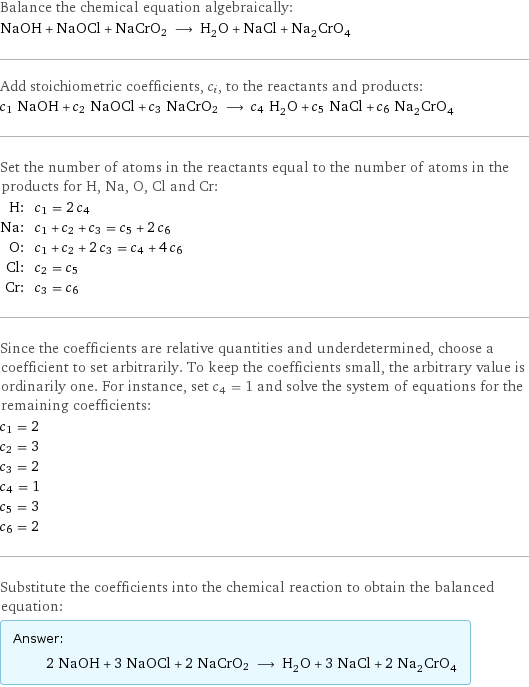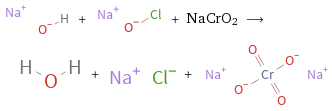Input interpretation

NaOH sodium hydroxide + NaOCl sodium hypochlorite + NaCrO2 ⟶ H_2O water + NaCl sodium chloride + Na_2CrO_4 sodium chromate
Balanced equation

Balance the chemical equation algebraically: NaOH + NaOCl + NaCrO2 ⟶ H_2O + NaCl + Na_2CrO_4 Add stoichiometric coefficients, c_i, to the reactants and products: c_1 NaOH + c_2 NaOCl + c_3 NaCrO2 ⟶ c_4 H_2O + c_5 NaCl + c_6 Na_2CrO_4 Set the number of atoms in the reactants equal to the number of atoms in the products for H, Na, O, Cl and Cr: H: | c_1 = 2 c_4 Na: | c_1 + c_2 + c_3 = c_5 + 2 c_6 O: | c_1 + c_2 + 2 c_3 = c_4 + 4 c_6 Cl: | c_2 = c_5 Cr: | c_3 = c_6 Since the coefficients are relative quantities and underdetermined, choose a coefficient to set arbitrarily. To keep the coefficients small, the arbitrary value is ordinarily one. For instance, set c_4 = 1 and solve the system of equations for the remaining coefficients: c_1 = 2 c_2 = 3 c_3 = 2 c_4 = 1 c_5 = 3 c_6 = 2 Substitute the coefficients into the chemical reaction to obtain the balanced equation: Answer: | | 2 NaOH + 3 NaOCl + 2 NaCrO2 ⟶ H_2O + 3 NaCl + 2 Na_2CrO_4
Structures

+ + NaCrO2 ⟶ + +
Names

sodium hydroxide + sodium hypochlorite + NaCrO2 ⟶ water + sodium chloride + sodium chromate
Equilibrium constant
![Construct the equilibrium constant, K, expression for: NaOH + NaOCl + NaCrO2 ⟶ H_2O + NaCl + Na_2CrO_4 Plan: • Balance the chemical equation. • Determine the stoichiometric numbers. • Assemble the activity expression for each chemical species. • Use the activity expressions to build the equilibrium constant expression. Write the balanced chemical equation: 2 NaOH + 3 NaOCl + 2 NaCrO2 ⟶ H_2O + 3 NaCl + 2 Na_2CrO_4 Assign stoichiometric numbers, ν_i, using the stoichiometric coefficients, c_i, from the balanced chemical equation in the following manner: ν_i = -c_i for reactants and ν_i = c_i for products: chemical species | c_i | ν_i NaOH | 2 | -2 NaOCl | 3 | -3 NaCrO2 | 2 | -2 H_2O | 1 | 1 NaCl | 3 | 3 Na_2CrO_4 | 2 | 2 Assemble the activity expressions accounting for the state of matter and ν_i: chemical species | c_i | ν_i | activity expression NaOH | 2 | -2 | ([NaOH])^(-2) NaOCl | 3 | -3 | ([NaOCl])^(-3) NaCrO2 | 2 | -2 | ([NaCrO2])^(-2) H_2O | 1 | 1 | [H2O] NaCl | 3 | 3 | ([NaCl])^3 Na_2CrO_4 | 2 | 2 | ([Na2CrO4])^2 The equilibrium constant symbol in the concentration basis is: K_c Mulitply the activity expressions to arrive at the K_c expression: Answer: | | K_c = ([NaOH])^(-2) ([NaOCl])^(-3) ([NaCrO2])^(-2) [H2O] ([NaCl])^3 ([Na2CrO4])^2 = ([H2O] ([NaCl])^3 ([Na2CrO4])^2)/(([NaOH])^2 ([NaOCl])^3 ([NaCrO2])^2)](../image_source/be9c4884fc7813e536d6c9a7971b16f2.png)
Construct the equilibrium constant, K, expression for: NaOH + NaOCl + NaCrO2 ⟶ H_2O + NaCl + Na_2CrO_4 Plan: • Balance the chemical equation. • Determine the stoichiometric numbers. • Assemble the activity expression for each chemical species. • Use the activity expressions to build the equilibrium constant expression. Write the balanced chemical equation: 2 NaOH + 3 NaOCl + 2 NaCrO2 ⟶ H_2O + 3 NaCl + 2 Na_2CrO_4 Assign stoichiometric numbers, ν_i, using the stoichiometric coefficients, c_i, from the balanced chemical equation in the following manner: ν_i = -c_i for reactants and ν_i = c_i for products: chemical species | c_i | ν_i NaOH | 2 | -2 NaOCl | 3 | -3 NaCrO2 | 2 | -2 H_2O | 1 | 1 NaCl | 3 | 3 Na_2CrO_4 | 2 | 2 Assemble the activity expressions accounting for the state of matter and ν_i: chemical species | c_i | ν_i | activity expression NaOH | 2 | -2 | ([NaOH])^(-2) NaOCl | 3 | -3 | ([NaOCl])^(-3) NaCrO2 | 2 | -2 | ([NaCrO2])^(-2) H_2O | 1 | 1 | [H2O] NaCl | 3 | 3 | ([NaCl])^3 Na_2CrO_4 | 2 | 2 | ([Na2CrO4])^2 The equilibrium constant symbol in the concentration basis is: K_c Mulitply the activity expressions to arrive at the K_c expression: Answer: | | K_c = ([NaOH])^(-2) ([NaOCl])^(-3) ([NaCrO2])^(-2) [H2O] ([NaCl])^3 ([Na2CrO4])^2 = ([H2O] ([NaCl])^3 ([Na2CrO4])^2)/(([NaOH])^2 ([NaOCl])^3 ([NaCrO2])^2)
Rate of reaction
![Construct the rate of reaction expression for: NaOH + NaOCl + NaCrO2 ⟶ H_2O + NaCl + Na_2CrO_4 Plan: • Balance the chemical equation. • Determine the stoichiometric numbers. • Assemble the rate term for each chemical species. • Write the rate of reaction expression. Write the balanced chemical equation: 2 NaOH + 3 NaOCl + 2 NaCrO2 ⟶ H_2O + 3 NaCl + 2 Na_2CrO_4 Assign stoichiometric numbers, ν_i, using the stoichiometric coefficients, c_i, from the balanced chemical equation in the following manner: ν_i = -c_i for reactants and ν_i = c_i for products: chemical species | c_i | ν_i NaOH | 2 | -2 NaOCl | 3 | -3 NaCrO2 | 2 | -2 H_2O | 1 | 1 NaCl | 3 | 3 Na_2CrO_4 | 2 | 2 The rate term for each chemical species, B_i, is 1/ν_i(Δ[B_i])/(Δt) where [B_i] is the amount concentration and t is time: chemical species | c_i | ν_i | rate term NaOH | 2 | -2 | -1/2 (Δ[NaOH])/(Δt) NaOCl | 3 | -3 | -1/3 (Δ[NaOCl])/(Δt) NaCrO2 | 2 | -2 | -1/2 (Δ[NaCrO2])/(Δt) H_2O | 1 | 1 | (Δ[H2O])/(Δt) NaCl | 3 | 3 | 1/3 (Δ[NaCl])/(Δt) Na_2CrO_4 | 2 | 2 | 1/2 (Δ[Na2CrO4])/(Δt) (for infinitesimal rate of change, replace Δ with d) Set the rate terms equal to each other to arrive at the rate expression: Answer: | | rate = -1/2 (Δ[NaOH])/(Δt) = -1/3 (Δ[NaOCl])/(Δt) = -1/2 (Δ[NaCrO2])/(Δt) = (Δ[H2O])/(Δt) = 1/3 (Δ[NaCl])/(Δt) = 1/2 (Δ[Na2CrO4])/(Δt) (assuming constant volume and no accumulation of intermediates or side products)](../image_source/ad52a22e4fbd76ec74ae905c0316406b.png)
Construct the rate of reaction expression for: NaOH + NaOCl + NaCrO2 ⟶ H_2O + NaCl + Na_2CrO_4 Plan: • Balance the chemical equation. • Determine the stoichiometric numbers. • Assemble the rate term for each chemical species. • Write the rate of reaction expression. Write the balanced chemical equation: 2 NaOH + 3 NaOCl + 2 NaCrO2 ⟶ H_2O + 3 NaCl + 2 Na_2CrO_4 Assign stoichiometric numbers, ν_i, using the stoichiometric coefficients, c_i, from the balanced chemical equation in the following manner: ν_i = -c_i for reactants and ν_i = c_i for products: chemical species | c_i | ν_i NaOH | 2 | -2 NaOCl | 3 | -3 NaCrO2 | 2 | -2 H_2O | 1 | 1 NaCl | 3 | 3 Na_2CrO_4 | 2 | 2 The rate term for each chemical species, B_i, is 1/ν_i(Δ[B_i])/(Δt) where [B_i] is the amount concentration and t is time: chemical species | c_i | ν_i | rate term NaOH | 2 | -2 | -1/2 (Δ[NaOH])/(Δt) NaOCl | 3 | -3 | -1/3 (Δ[NaOCl])/(Δt) NaCrO2 | 2 | -2 | -1/2 (Δ[NaCrO2])/(Δt) H_2O | 1 | 1 | (Δ[H2O])/(Δt) NaCl | 3 | 3 | 1/3 (Δ[NaCl])/(Δt) Na_2CrO_4 | 2 | 2 | 1/2 (Δ[Na2CrO4])/(Δt) (for infinitesimal rate of change, replace Δ with d) Set the rate terms equal to each other to arrive at the rate expression: Answer: | | rate = -1/2 (Δ[NaOH])/(Δt) = -1/3 (Δ[NaOCl])/(Δt) = -1/2 (Δ[NaCrO2])/(Δt) = (Δ[H2O])/(Δt) = 1/3 (Δ[NaCl])/(Δt) = 1/2 (Δ[Na2CrO4])/(Δt) (assuming constant volume and no accumulation of intermediates or side products)
Chemical names and formulas

| sodium hydroxide | sodium hypochlorite | NaCrO2 | water | sodium chloride | sodium chromate formula | NaOH | NaOCl | NaCrO2 | H_2O | NaCl | Na_2CrO_4 Hill formula | HNaO | ClNaO | CrNaO2 | H_2O | ClNa | CrNa_2O_4 name | sodium hydroxide | sodium hypochlorite | | water | sodium chloride | sodium chromate IUPAC name | sodium hydroxide | sodium hypochlorite | | water | sodium chloride | disodium dioxido(dioxo)chromium
Substance properties

| sodium hydroxide | sodium hypochlorite | NaCrO2 | water | sodium chloride | sodium chromate molar mass | 39.997 g/mol | 74.44 g/mol | 106.98 g/mol | 18.015 g/mol | 58.44 g/mol | 161.97 g/mol phase | solid (at STP) | liquid (at STP) | | liquid (at STP) | solid (at STP) | solid (at STP) melting point | 323 °C | -6 °C | | 0 °C | 801 °C | 780 °C boiling point | 1390 °C | | | 99.9839 °C | 1413 °C | density | 2.13 g/cm^3 | 1.11 g/cm^3 | | 1 g/cm^3 | 2.16 g/cm^3 | 2.698 g/cm^3 solubility in water | soluble | miscible | | | soluble | surface tension | 0.07435 N/m | | | 0.0728 N/m | | dynamic viscosity | 0.004 Pa s (at 350 °C) | | | 8.9×10^-4 Pa s (at 25 °C) | | odor | | | | odorless | odorless |
Units
